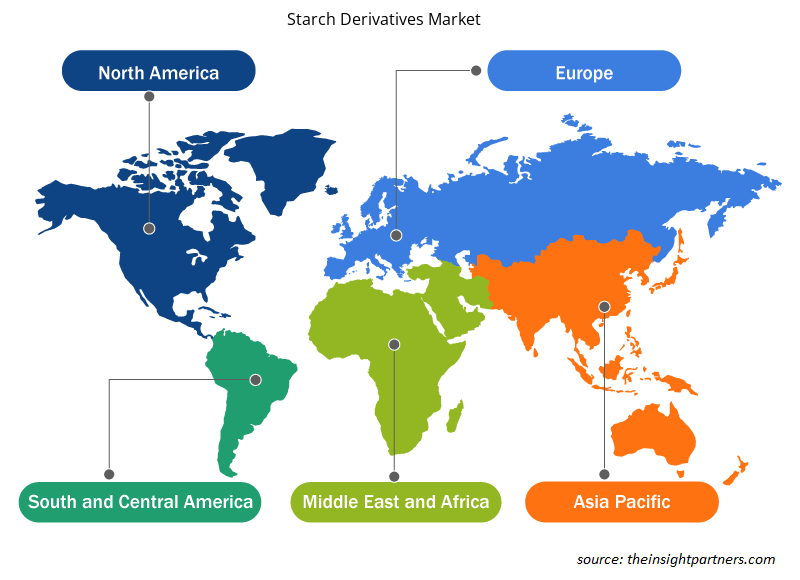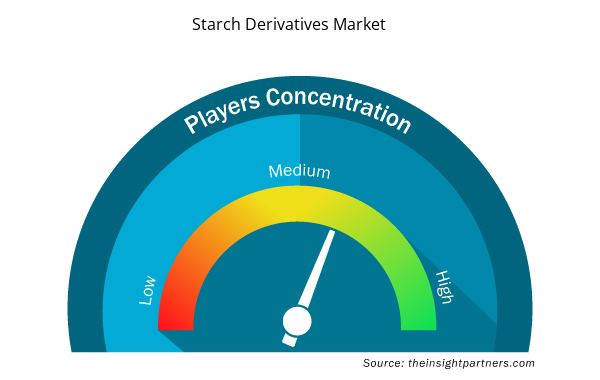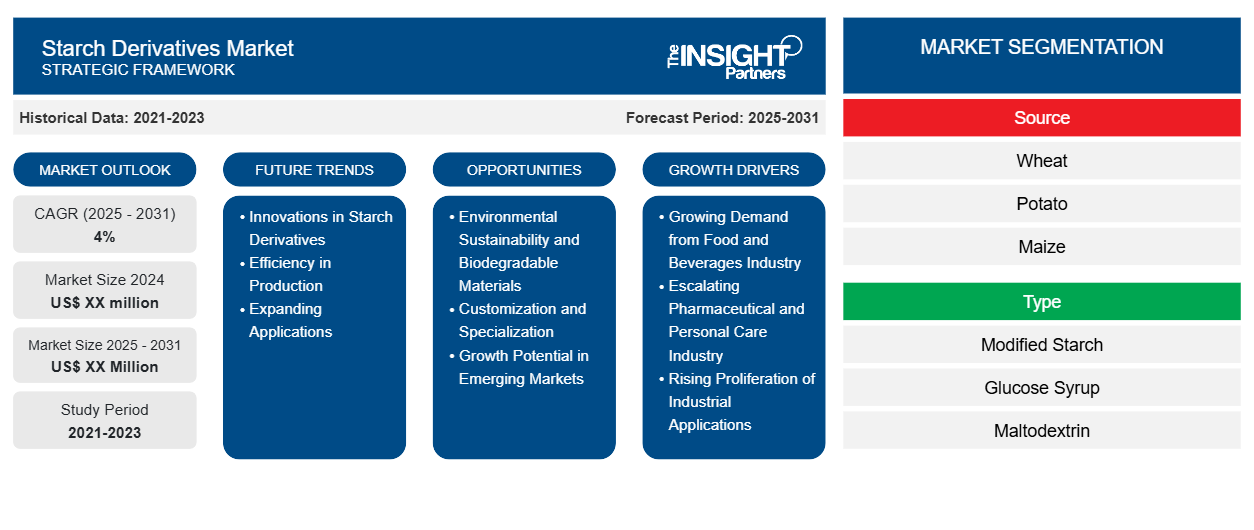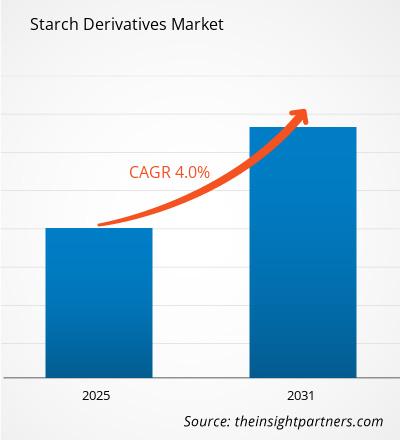Le marché des dérivés de l'amidon devrait enregistrer un TCAC de 4 % de 2023 à 2031, avec une taille de marché passant de XX millions USD en 2023 à XX millions USD d'ici 2031.
Le rapport est segmenté par source (blé, pomme de terre, maïs, manioc et autres) et type (amidon modifié, sirop de glucose, maltodextrine, dextrose, polyols et autres). Le rapport présente en outre une analyse basée sur l'industrie d'utilisation finale [aliments et boissons (boulangerie et confiserie, boissons, aliments prêts à consommer et prêts à consommer, produits laitiers et autres), pâtes et papiers (carton ondulé, papier d'impression/écriture, mouchoirs et essuie-tout et autres), produits pharmaceutiques, aliments pour animaux, textiles et autres]. L'analyse mondiale est ensuite décomposée au niveau régional et par principaux pays. La taille du marché et les prévisions aux niveaux mondial, régional et national pour tous les segments de marché clés sont couvertes dans le cadre du rapport. Le rapport offre la valeur en USD pour l'analyse et les segments ci-dessus. Le rapport fournit des statistiques clés sur l'état du marché des principaux acteurs du marché et offre des tendances et des opportunités de marché.
Objectif du rapport
Le rapport Starch Derivatives Market de The Insight Partners vise à décrire le paysage actuel et la croissance future, les principaux facteurs moteurs, les défis et les opportunités. Cela fournira des informations à diverses parties prenantes commerciales, telles que :
- Fournisseurs/fabricants de technologie : pour comprendre l’évolution de la dynamique du marché et connaître les opportunités de croissance potentielles, leur permettant de prendre des décisions stratégiques éclairées.
- Investisseurs : Effectuer une analyse complète des tendances concernant le taux de croissance du marché, les projections financières du marché et les opportunités qui existent tout au long de la chaîne de valeur.
- Organismes de réglementation : Réglementer les politiques et surveiller les activités du marché dans le but de minimiser les abus, de préserver la confiance des investisseurs et de maintenir l’intégrité et la stabilité du marché.
Segmentation du marché des dérivés de l'amidon
Source
- Blé
- Pomme de terre
- Maïs
- Manioc
Taper
- Amidon modifié
- Sirop de glucose
- Maltodextrine
- Dextrose
- Polyols
Secteur d'utilisation finale [Aliments et boissons, pâtes et papiers, produits pharmaceutiques, aliments pour animaux, textiles]
Géographie
- Amérique du Nord
- Europe
- Asie-Pacifique
- Amérique du Sud et Amérique centrale
- Moyen-Orient et Afrique
Géographie
- Amérique du Nord
- Europe
- Asie-Pacifique
- Amérique du Sud et Amérique centrale
- Moyen-Orient et Afrique
Personnalisez ce rapport en fonction de vos besoins
Vous bénéficierez d'une personnalisation gratuite de n'importe quel rapport, y compris de certaines parties de ce rapport, d'une analyse au niveau des pays, d'un pack de données Excel, ainsi que de superbes offres et réductions pour les start-ups et les universités.
- Obtenez les principales tendances clés du marché de ce rapport.Cet échantillon GRATUIT comprendra une analyse de données, allant des tendances du marché aux estimations et prévisions.
Facteurs de croissance du marché des dérivés de l'amidon
- Demande croissante de l'industrie agroalimentaire : les aliments et les boissons sont les principaux moteurs du marché des dérivés de l'amidon. Divers produits alimentaires et boissons, notamment les aliments transformés et sur mesure, comme les sauces, les vinaigrettes et les boissons, utilisent des dérivés de l'amidon comme épaississants, stabilisants et émulsifiants. Les dérivés de l'amidon sont de plus en plus intégrés dans l'industrie agroalimentaire et des boissons, principalement en raison de la demande croissante d'aliments prêts à consommer pratiques et de produits clean label, tout en stimulant les processus de production rentables.
- L'industrie pharmaceutique et des soins personnels en plein essor : Les industries pharmaceutiques et des soins personnels contribuent également de manière significative à la croissance du marché des dérivés de l'amidon. Parmi les applications des dérivés de l'amidon dans les produits pharmaceutiques figurent les liants, les désintégrants et les enrobages de comprimés, tandis que dans les produits de soins personnels, les dérivés amylacés se trouvent dans les lotions, les crèmes et les shampooings. L'accent accru mis sur le développement de formulations sûres et efficaces a fait augmenter la demande d'ingrédients à base d'amidon dans ces industries.
- Prolifération croissante des applications industrielles : les dérivés de l'amidon ont des applications dans divers secteurs industriels, notamment le papier, le textile et la construction. Dans l'industrie du papier, ils sont utilisés comme agents de collage ; dans l'industrie textile, comme épaississants ou liants. Les dérivés de l'amidon fonctionnent dans la construction comme agents de rétention d'eau et modificateurs de rhéologie. La demande industrielle accrue pour ces applications a en effet étiré le marché des dérivés de l'amidon.
Tendances futures du marché des dérivés de l'amidon
- Innovations dans les dérivés de l'amidon : De nombreuses innovations ont été réalisées dans le développement de nouveaux dérivés de l'amidon destinés aux consommateurs, en phase avec l'évolution des besoins de l'industrie. Cette nouvelle tendance consistant à proposer des dérivés de l'amidon non OGM et biologiques ou clean label a suscité une attention considérable de la part des consommateurs qui exigent des ingrédients d'origine naturelle et durable.
- Efficacité de la production : les procédés de production de dérivés de l'amidon sont en cours de développement pour produire des produits plus efficaces, moins chers et de meilleure qualité. L'automatisation, la numérisation, les méthodes de traitement avancées et d'excellentes techniques sont à la disposition des entreprises de fabrication pour devenir plus efficaces dans leurs opérations face à la demande croissante du marché.
- Élargissement des applications : De nouvelles applications pour les dérivés de l'amidon au-delà des utilisations classiques apparaissent en permanence grâce aux activités de recherche et développement continues entreprises. Un exemple est l'utilisation de dérivés de l'amidon dans les aliments fonctionnels, qui a ajouté des avantages pour la santé et ouvert de nouveaux marchés.
Opportunités de marché pour les dérivés de l'amidon
- Durabilité environnementale et matériaux biodégradables : L'un des principaux facteurs à l'origine de ce développement des dérivés de l'amidon en matériaux verts et biodégradables est la préoccupation croissante pour la durabilité environnementale. Les fabricants ont tendance à s'appuyer davantage sur des matériaux renouvelables, recyclables et compostables pour répondre aux besoins croissants en matière d'emballages et de formulations de produits durables.
- Personnalisation et spécialisation : les industries ayant des exigences de plus en plus spécialisées, le besoin de solutions dérivées d'amidon personnalisées ou spécialisées continue de croître. Les fabricants peuvent ainsi utiliser cette tendance pour développer des produits sur mesure qui répondent aux exigences de différents secteurs d'utilisation finale, tels que les produits pharmaceutiques, les soins personnels et les applications industrielles.
- Potentiel de croissance dans les marchés émergents : Le marché des dérivés de l'amidon regorge d'un potentiel de croissance important dans les pays émergents où les aliments transformés, les produits de soins personnels et les applications industrielles sont très demandés. Ainsi, les fabricants peuvent désormais jouer leur rôle en façonnant le profil ou la stratégie de commercialisation de leurs portefeuilles de produits en fonction des exigences et des préférences spécifiques de ces marchés pour obtenir de nouvelles opportunités de revenus et élargir davantage leur présence mondiale.
Aperçu régional du marché des dérivés de l'amidon
Les tendances régionales et les facteurs influençant le marché des dérivés de l’amidon tout au long de la période de prévision ont été expliqués en détail par les analystes d’Insight Partners. Cette section traite également des segments et de la géographie du marché des dérivés de l’amidon en Amérique du Nord, en Europe, en Asie-Pacifique, au Moyen-Orient et en Afrique, ainsi qu’en Amérique du Sud et en Amérique centrale.

- Obtenez les données régionales spécifiques au marché des dérivés de l'amidon
Portée du rapport sur le marché des dérivés de l'amidon
| Attribut de rapport | Détails |
|---|---|
| Taille du marché en 2023 | XX millions de dollars américains |
| Taille du marché d'ici 2031 | XX millions de dollars américains |
| Taux de croissance annuel composé mondial (2023-2031) | 4% |
| Données historiques | 2021-2022 |
| Période de prévision | 2024-2031 |
| Segments couverts | Par source
|
| Régions et pays couverts | Amérique du Nord
|
| Leaders du marché et profils d'entreprises clés |
|
Densité des acteurs du marché des dérivés de l'amidon : comprendre son impact sur la dynamique des entreprises
Le marché des dérivés de l'amidon connaît une croissance rapide, tirée par la demande croissante des utilisateurs finaux en raison de facteurs tels que l'évolution des préférences des consommateurs, les avancées technologiques et une plus grande sensibilisation aux avantages du produit. À mesure que la demande augmente, les entreprises élargissent leurs offres, innovent pour répondre aux besoins des consommateurs et capitalisent sur les tendances émergentes, ce qui alimente davantage la croissance du marché.
La densité des acteurs du marché fait référence à la répartition des entreprises ou des sociétés opérant sur un marché ou un secteur particulier. Elle indique le nombre de concurrents (acteurs du marché) présents sur un marché donné par rapport à sa taille ou à sa valeur marchande totale.
Les principales entreprises opérant sur le marché des dérivés de l'amidon sont :
- SMA
- Groupe Agrana
- Avebe UA
- Cargill Inc.
- Groupe Emsland
Avis de non-responsabilité : les sociétés répertoriées ci-dessus ne sont pas classées dans un ordre particulier.

- Obtenez un aperçu des principaux acteurs du marché des dérivés de l'amidon
Principaux arguments de vente
- Couverture complète : Le rapport couvre de manière exhaustive l’analyse des produits, des services, des types et des utilisateurs finaux du marché des dérivés de l’amidon, offrant un paysage holistique.
- Analyse d’experts : Le rapport est compilé sur la base d’une compréhension approfondie des experts et analystes du secteur.
- Informations à jour : Le rapport garantit la pertinence commerciale en raison de sa couverture des informations récentes et des tendances des données.
- Options de personnalisation : ce rapport peut être personnalisé pour répondre aux exigences spécifiques du client et s'adapter parfaitement aux stratégies commerciales.
Le rapport de recherche sur le marché des dérivés de l’amidon peut donc aider à ouvrir la voie au décodage et à la compréhension du scénario de l’industrie et des perspectives de croissance. Bien qu’il puisse y avoir quelques préoccupations valables, les avantages globaux de ce rapport ont tendance à l’emporter sur les inconvénients.
- Analyse historique (2 ans), année de base, prévision (7 ans) avec TCAC
- Analyse PEST et SWO
- Taille du marché Valeur / Volume - Mondial, Régional, Pays
- Industrie et paysage concurrentiel
- Ensemble de données Excel


- Real-Time Location Systems Market
- Water Pipeline Leak Detection System Market
- Electronic Data Interchange Market
- Lymphedema Treatment Market
- Underwater Connector Market
- Piling Machines Market
- Nuclear Decommissioning Services Market
- Machine Condition Monitoring Market
- 3D Mapping and Modelling Market
- Lyophilization Services for Biopharmaceuticals Market

Report Coverage
Revenue forecast, Company Analysis, Industry landscape, Growth factors, and Trends

Segment Covered
This text is related
to segments covered.

Regional Scope
North America, Europe, Asia Pacific, Middle East & Africa, South & Central America

Country Scope
This text is related
to country scope.
Questions fréquemment posées
Innovative product formulations is expected to be the key market trends
The report can be delivered in PDF/Word format, we can also share excel data sheet based on request.
On the basis of geography, the starch derivatives market is classified into North America, Europe, Asia Pacific, Middle East and Africa, and South and Central America
ADM; AGRANA Beteiligungs-AG; Cargill Inc; COPAM; Interstarch GmbH are some of the key players operating in the starch derivatives market
Growth in the food and beverages industry is driving the market growth
The Starch Derivatives Market is estimated to witness a CAGR of 4% from 2023 to 2031
Trends and growth analysis reports related to Chemicals and Materials : READ MORE..
1. ADM
2. Agrana Group
3. Avebe U.A.
4. Cargill Inc.
5. Emsland Group
6. Grain Processing Corporation
7. Ingredion Incorporated
8. Roquette Fr¨res
9. Tate and Lyle PLC
10. Zhucheng Dongxiao Biotechnology Co.
The Insight Partners performs research in 4 major stages: Data Collection & Secondary Research, Primary Research, Data Analysis and Data Triangulation & Final Review.
- Data Collection and Secondary Research:
As a market research and consulting firm operating from a decade, we have published and advised several client across the globe. First step for any study will start with an assessment of currently available data and insights from existing reports. Further, historical and current market information is collected from Investor Presentations, Annual Reports, SEC Filings, etc., and other information related to company’s performance and market positioning are gathered from Paid Databases (Factiva, Hoovers, and Reuters) and various other publications available in public domain.
Several associations trade associates, technical forums, institutes, societies and organization are accessed to gain technical as well as market related insights through their publications such as research papers, blogs and press releases related to the studies are referred to get cues about the market. Further, white papers, journals, magazines, and other news articles published in last 3 years are scrutinized and analyzed to understand the current market trends.
- Primary Research:
The primarily interview analysis comprise of data obtained from industry participants interview and answers to survey questions gathered by in-house primary team.
For primary research, interviews are conducted with industry experts/CEOs/Marketing Managers/VPs/Subject Matter Experts from both demand and supply side to get a 360-degree view of the market. The primary team conducts several interviews based on the complexity of the markets to understand the various market trends and dynamics which makes research more credible and precise.
A typical research interview fulfils the following functions:
- Provides first-hand information on the market size, market trends, growth trends, competitive landscape, and outlook
- Validates and strengthens in-house secondary research findings
- Develops the analysis team’s expertise and market understanding
Primary research involves email interactions and telephone interviews for each market, category, segment, and sub-segment across geographies. The participants who typically take part in such a process include, but are not limited to:
- Industry participants: VPs, business development managers, market intelligence managers and national sales managers
- Outside experts: Valuation experts, research analysts and key opinion leaders specializing in the electronics and semiconductor industry.
Below is the breakup of our primary respondents by company, designation, and region:

Once we receive the confirmation from primary research sources or primary respondents, we finalize the base year market estimation and forecast the data as per the macroeconomic and microeconomic factors assessed during data collection.
- Data Analysis:
Once data is validated through both secondary as well as primary respondents, we finalize the market estimations by hypothesis formulation and factor analysis at regional and country level.
- Macro-Economic Factor Analysis:
We analyse macroeconomic indicators such the gross domestic product (GDP), increase in the demand for goods and services across industries, technological advancement, regional economic growth, governmental policies, the influence of COVID-19, PEST analysis, and other aspects. This analysis aids in setting benchmarks for various nations/regions and approximating market splits. Additionally, the general trend of the aforementioned components aid in determining the market's development possibilities.
- Country Level Data:
Various factors that are especially aligned to the country are taken into account to determine the market size for a certain area and country, including the presence of vendors, such as headquarters and offices, the country's GDP, demand patterns, and industry growth. To comprehend the market dynamics for the nation, a number of growth variables, inhibitors, application areas, and current market trends are researched. The aforementioned elements aid in determining the country's overall market's growth potential.
- Company Profile:
The “Table of Contents” is formulated by listing and analyzing more than 25 - 30 companies operating in the market ecosystem across geographies. However, we profile only 10 companies as a standard practice in our syndicate reports. These 10 companies comprise leading, emerging, and regional players. Nonetheless, our analysis is not restricted to the 10 listed companies, we also analyze other companies present in the market to develop a holistic view and understand the prevailing trends. The “Company Profiles” section in the report covers key facts, business description, products & services, financial information, SWOT analysis, and key developments. The financial information presented is extracted from the annual reports and official documents of the publicly listed companies. Upon collecting the information for the sections of respective companies, we verify them via various primary sources and then compile the data in respective company profiles. The company level information helps us in deriving the base number as well as in forecasting the market size.
- Developing Base Number:
Aggregation of sales statistics (2020-2022) and macro-economic factor, and other secondary and primary research insights are utilized to arrive at base number and related market shares for 2022. The data gaps are identified in this step and relevant market data is analyzed, collected from paid primary interviews or databases. On finalizing the base year market size, forecasts are developed on the basis of macro-economic, industry and market growth factors and company level analysis.
- Data Triangulation and Final Review:
The market findings and base year market size calculations are validated from supply as well as demand side. Demand side validations are based on macro-economic factor analysis and benchmarks for respective regions and countries. In case of supply side validations, revenues of major companies are estimated (in case not available) based on industry benchmark, approximate number of employees, product portfolio, and primary interviews revenues are gathered. Further revenue from target product/service segment is assessed to avoid overshooting of market statistics. In case of heavy deviations between supply and demand side values, all thes steps are repeated to achieve synchronization.
We follow an iterative model, wherein we share our research findings with Subject Matter Experts (SME’s) and Key Opinion Leaders (KOLs) until consensus view of the market is not formulated – this model negates any drastic deviation in the opinions of experts. Only validated and universally acceptable research findings are quoted in our reports.
We have important check points that we use to validate our research findings – which we call – data triangulation, where we validate the information, we generate from secondary sources with primary interviews and then we re-validate with our internal data bases and Subject matter experts. This comprehensive model enables us to deliver high quality, reliable data in shortest possible time.


 Obtenez un échantillon gratuit pour ce rapport
Obtenez un échantillon gratuit pour ce rapport